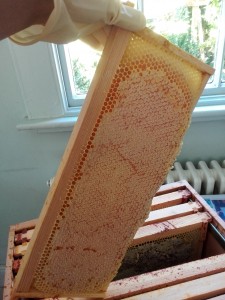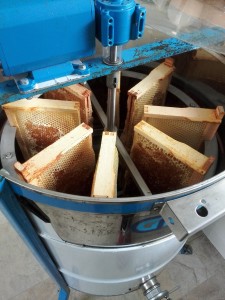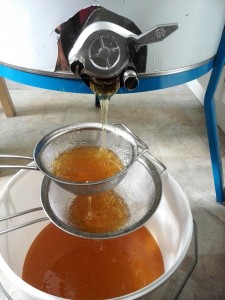I usually start in the early morning to clear the bees off the super boxes, that is the box where bees store honey and the queen is blocked from getting in by the queen excluder, so that there is no brood in the super, only honey. In the previous night, I put in a clearing board between the brood box and the supers, the clearing board only allows the bees to go down to the brood, but not going back easily. What is supposed to happen is, during the night, the bees go down to the brood box to warm the babies and in the morning, they find it difficult to go back to their honey stores. While that is the theory, usually there are a number of bees left in the super that I have to carefully brush them off frame by frame. They are really clever and discover the super that has been put aside and free of bees very quickly and my dad has to run back to the house with each super as soon as they are cleared. It is hard work to hold the heavy frame and brush it, but I sort of enjoying it, the smell of honey and pollen around the open hives is just lovely.
Finally all the supers are in the kitchen. Starting the extraction.

Step 1, was to de-cap the honeycomb. When each cell in the honeycomb is filled with honey, the bees put wax to cap it. Really each cell has to be de-capped, otherwise the honey won’t come out. I used a bread knife at the start, then found the de-capping fork actually worked better. The extractor I rented from my beekeepers’ association took eight frames, and it took me good part of an hour to de-cap all the eight frames, remember, no cells left uncapped.

Step 2, extraction, that was easy. The frames were loaded into the electric extractor. It was switched on and started from low speed and then moved to higher speed. Honey just splashed out! I must have done a good job in balancing the frames, the extractor was steady on the floor. It was funny that someone actually managed to let it dancing across the floor 😉

Step 3, straining. There are bits of wax in the honey, most people like clear honey without it. So we have to strain it. I used double sieves to strain the honey. I tell you it is slow, probably because the consistency of the honey at room temperature. It is quite thick. I heard the commercial producers heat the honey to speed up the process. Some even use ultra fine sieve to filter out the pollen, so the origin of the honey can not be traced. I don’t agree with that, local honey should be just as it is with all the goodness from the bees. I also don’t understand why all the commercial honey are blended – you see “blended from EU and non EU honey” in the label of Boyne Vally honey – I’ll need to do research on that. But my honey is straight from Meadow bees and I only did an extraction and I am happy with it.

Finally finished with the extraction, it was almost mid night, left the clean up to the next day!